|
0 Comments
A version of this piece appears in Scilly Now & Then's October/November issue, on sale locally.
As you’re reading this, we will have completed our first ever Scilly Dark Skies Week, where we welcomed some fantastic speakers from many fields of astronomy, to our observatory on St Martin’s. With the generosity of spirit we know so well on Scilly, they shared their expertise with keen learners of all levels of experience. The brilliant thing about astronomy as a pursuit is that you can never know it all. And so we keep learning together. It’s always been our aim to nurture a community of astronomers both residents and visitors on Scilly, and our Dark Skies Week is another step towards that. Our speakers included Cornwall-based archeo-astronomer Carolyn Kennett who wowed us with incredible connections between some of Cornwall & Scilly's pre-historic monuments and the Sun. It's mind-blowing that we're just the latest in a long, long history of humans in our part of the world, gazing up at the stars! Damian Peach joined us via the medium of Zoom to talk us through the art of astrophotography , whose images have regularly been shortlisted in the Astronomy Photographer of the Year competition. COSMOS regulars Mark Holmes and Ian Morison gave great talks, grounding us in the basics of astrophotography, the importance of community observatories (though Ian did blow a few more minds with his talk on the Milky Way and galaxies beyond!). We were so lucky to have them both here all week to help out and share their expertise - they have both been here from the start, before COSMOS was 'a thing'. While the weather didn't always play ball - it's October in the UK, after all - we did get some decent telescope time, with stunning views of Jupiter and Saturn. We were delighted to have had Scilly Dark Skies Week listed as one of the few must-see events in The Sky At Night Magazine this month. Whether you made it or not, we hope the event will run annually, bringing Scilly astronomers together to enjoy interesting talks and dark October skies. To October skies. As the islands calm down for the year, the skies suddenly wake up. Darkening evenings and lights-on-in-the-mornings: whatever the Earth’s orbit may be doing to our circadian rhythms, there can be one thing to be sure of, more stargazing! (The prevalence of cloud is another matter; we can but watch the weather forecast, or, on Scilly, look out of the window and grab our moments.) There are a couple of meteor showers to watch out for in October. The Taurids peak towards the beginning of the month but continue to the middle of October – by no means prolific, up to 5 per hour but if you do catch one, you could witness some long, bright trails! By 21 October, we’re into the peak of the Orionids, but unfortunately a big, bright Moon might inhibit some seeing. The likelihood of observing this or that isn’t something that should stop you grabbing any clear night on Scilly to look up, as you will be awed by the sheer number of stars you can see; the Milky Way, coursing above, remains observable for at least the next month. Jupiter and Saturn shine brighter than any stars before midnight, in the south-western sky. Jupiter is much the brighter and will appear lower in the sky. Look slightly above and to the right for ringed Saturn. Add binoculars and you might get a sense of those magical ice and rock rings that make Saturn such a popular planet in our imagination. It’s been the ‘wow’ moment for many of our summer visitors, seeing these rings through a powerful telescope. High in the night sky at the moment, locate Cassiopeia, her wonky W shape, supposed to bring to mind the vainest of vain Greek queens reclining on her throne (astronomers have vivid imaginations). To the east of Cassiopeia, towards the constellation of Andromeda, you may – on a dark night – be able to make out the Andromeda galaxy with the naked eye, as a hazy patch of light. Andromeda is our nearest galaxy, at approximately 2.5 million light years away – that means any light you can see tonight is 2.5 million years old. Isn’t that something? Finally, British Summer Time ends on 31 October, so we welcome longer and longer nights – all the better for stargazing. Let us know what you’re looking at from wherever you are. Here's what we're looking at in our skies this month! To download this as a PDF, click here.
Here's what we're looking at this month. To download as a PDF, click here.
What a wonderful last couple of months we’ve had, as we’ve welcomed back visitors to the observatory’s open sessions on Tuesday nights and Friday afternoons! We’re seeing high demand for limited spaces, especially on Tuesdays, so please book in advance and be sure to let us know if you can no longer make it.
We run our open sessions rain or shine, so even if it’s cloudy and you don’t have the chance to look through a telescope with us, we’ll do our best to make sure you leave with more knowledge about Scilly’s night skies. July’s highlight for me was hosting the Year 4 and 5s from Five Islands Academy – so many enthusiastic questions, observations and breathy ‘wows’ as we got close up looks at the Moon through our powerful telescopes. Apparently the Moon is so close, you could be a frog and jump onto it, reported one young visitor. It’s been a tough last year, but my goodness, what a reminder that this was what the observatory was built for. August is a mighty fine month to stargaze on Scilly, as the nights begin to lengthen and the Milky Way arcs above us, a magnificent, hazy streak of distant light. This year, cloud permitting, we are in for one of the best. The annual Perseid meteor shower runs 8-16 August. The Perseids are one of the best known – and most spectacular – meteor showers in the astronomical calendar. These so-called shooting stars reach a sharp peak on 12 August, predicted to be between 20.00 and 23.00, which makes it an ideal stay-up-late treat for younger stargazers. Expect 100-plus gasp-inducing meteors an hour. There are very favourable conditions this year, as the Moon sets at 22.35, so will be out of the way. Make sure your eyes are properly adjusted before looking up – allow 20 minutes. Cross everything for a clear night! Gas giant Jupiter is prime viewing this month, too – reaching opposition on 19 August. Throughout the month, it’ll be viewable from 21.00 or thereabouts low in the southern sky – the islands’ long, low horizons are hugely advantageous. By late August Jupiter will be shining brightly as the 4th brightest object in the sky after the Sun, Moon and Venus. Even a small amount of magnification can reveal the planet’s striped atmospheric detail and can pick out the 4 Galilean moons (scientists believe Jupiter has 79 moons; the Galilean moons are the biggest: Io, Europa, Ganymede and Callisto, first noted by Galileo Galilei in 1609). Top fact: Jupiter’s so big you could fit all the other planets of the solar system inside it, and still have room for more! I’ll also be fixing my telescope on smaller but stunning ringed Saturn - not to be missed. Here's what we're looking at in Scilly's skies this August. Click here to download this as a PDF.
Here's what we're looking at in July's night skies. Click here to download this as a PDF.
It’s astronomy’s ‘low-season’ in June and July, as the longer hours of daylight limit truly dark skies to the wee small hours.
While it may not get completely dark while you are awake, make the most of clear nights. Just after sunset is one of my favourite times to ‘look up’, as you notice the first, brightest stars pop out, as the night sky starts to awaken. It’s also the right time of year to spot noctilucent clouds – these high-altitude clouds can appear dazzlingly bright, electric blue in the sky, up to 2 hours after sundown (or before sunrise) and above the northwest horizon. We’re very well placed for the opportunity to see NLCs on Scilly, with such low, open horizons and zero light pollution. Venus is bright all month, also above the northwest horizon, from about half an hour after sundown. It’s hard to miss at magnitude -3.8. Though it might seem odd, the lower the number, the brighter the object. So -3.8 Venus appears significantly brighter than Mars, at magnitude +1.8 from the middle of June. You can see our solar system’s planets because they reflect light, not emit it: the light you see is technically the Sun’s. There’s a good opportunity to compare the difference in planetary magnitude on 30 June, after 11pm, as Mars and Venus can be seen close together (approximately an outstretched palm apart) above the west-northwest horizon. With all this northwesterly sky action, it would be a good opportunity to head up to St Martin’s Daymark with a blanket and a flask of something! Scilly Dark Skies Week, 2-9 October 2021 We’ve announced the line-up for our Scilly Dark Skies Week 2021. Originally planned for 2020 but postponed due to the COVID-19 pandemic, we’re delighted to be going ahead on St Martin’s this year with the same speakers. We are thrilled to welcome internationally renowned astrophotographer Damian Peach, who has appeared on the BBC and the Discovery Channel. Peach's work has been used by NASA and the ESA to illustrate what ground-based telescopes can achieve in photographing the planets. Damian will lead a session on high-resolution astrophotography, sharing some of his many images, produced from the world’s largest telescopes. We’re also joined by Cornwall-based astronomer Carolyn Kennett who will be exploring the fascinating realm of astro-archaeology, the ancient connections between Scilly’s land and sky; Scilly Walks’ Katharine Sawyer will lead us on a walk to explore some of St Martins’ ancient sites with possible connections to the heavens. We couldn’t do Dark Skies Week without COSMOS regulars Ian Morison, now in his 54th year at the University of Manchester’s Jodrell Bank Observatory, and Mark Holmes of High Legh Community Observatory, who is ultimately to thank for helping us get our observatory plans off the ground! Tickets are £175 for the week, which includes daily workshops and nightly talks, plus guided stargazing. As ever, get in touch at [email protected] if you have any questions about visiting us or the night sky in Scilly. Here's what we're looking at this month. Click to download this as a PDF.
Here's what we're looking at in our skies this month. Click here to download this as a PDF.
|
BYCharlie Payne POSTS
September 2024
|


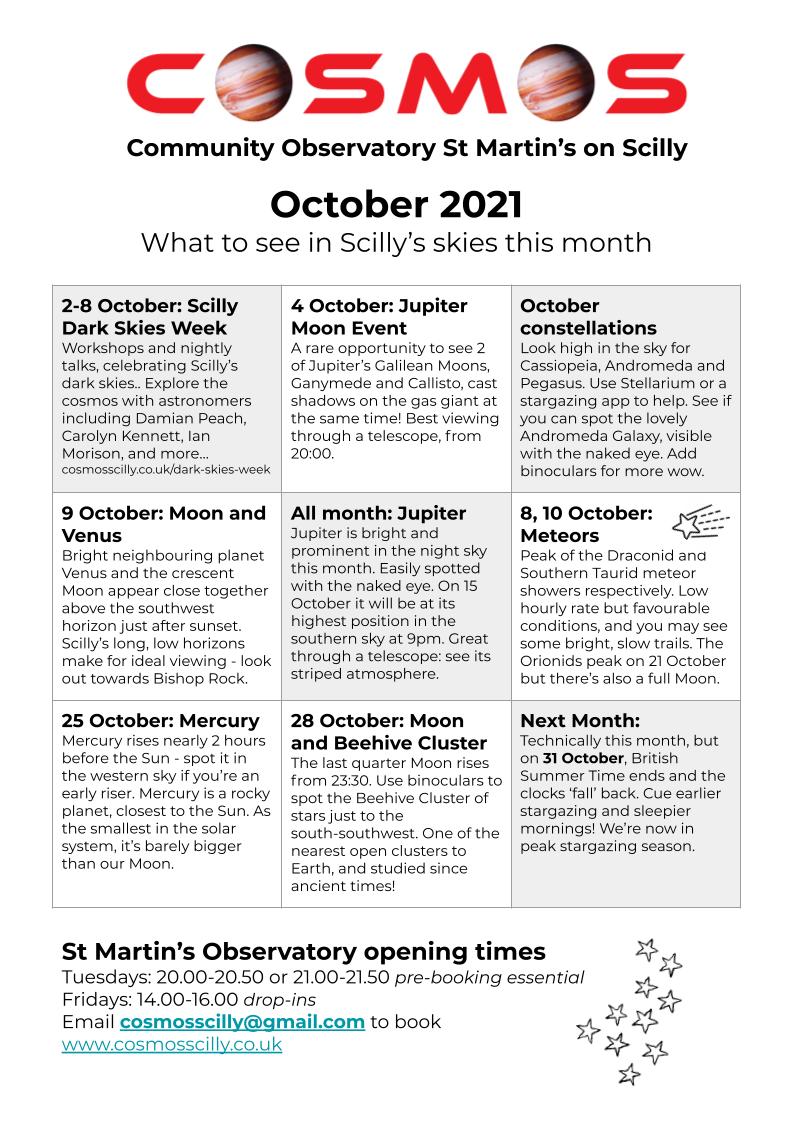
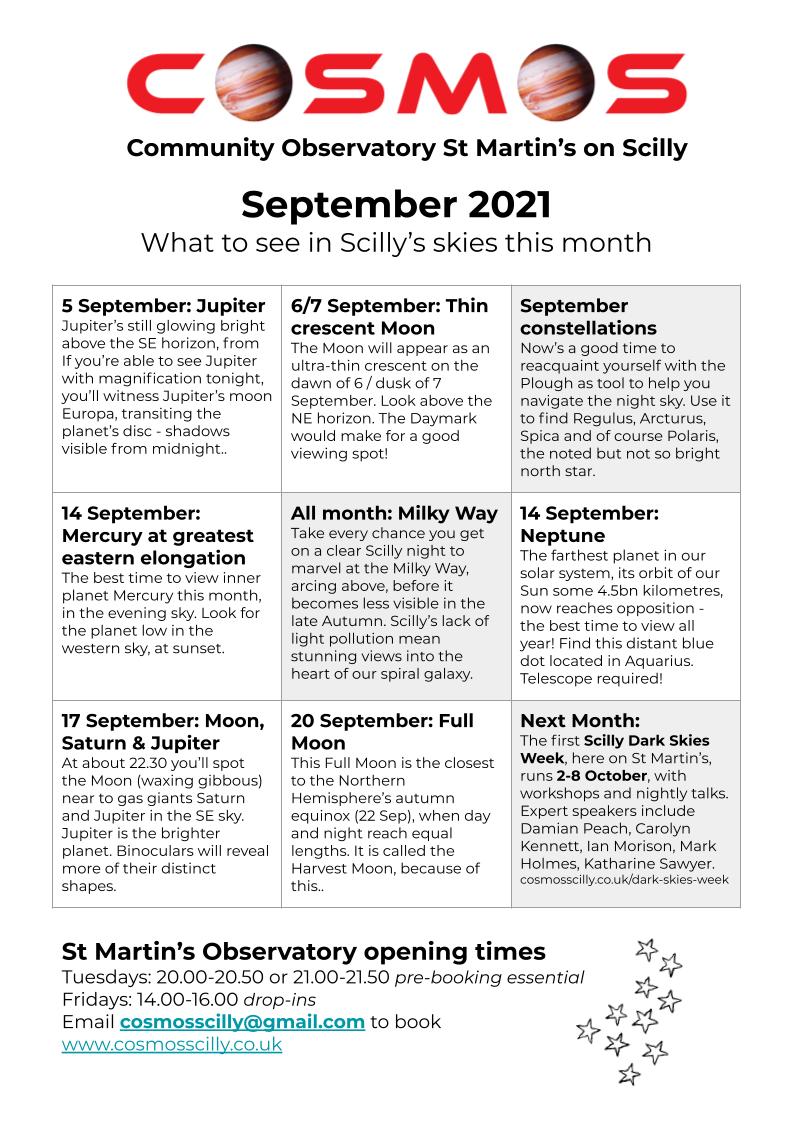
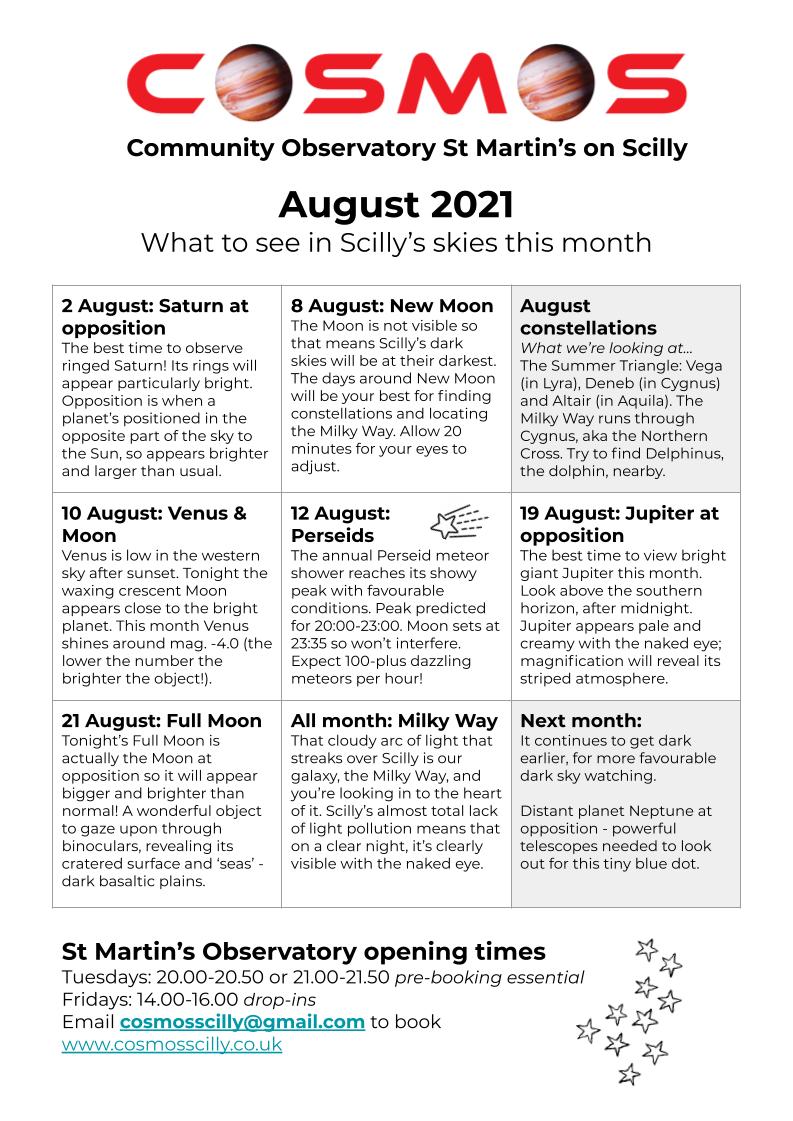
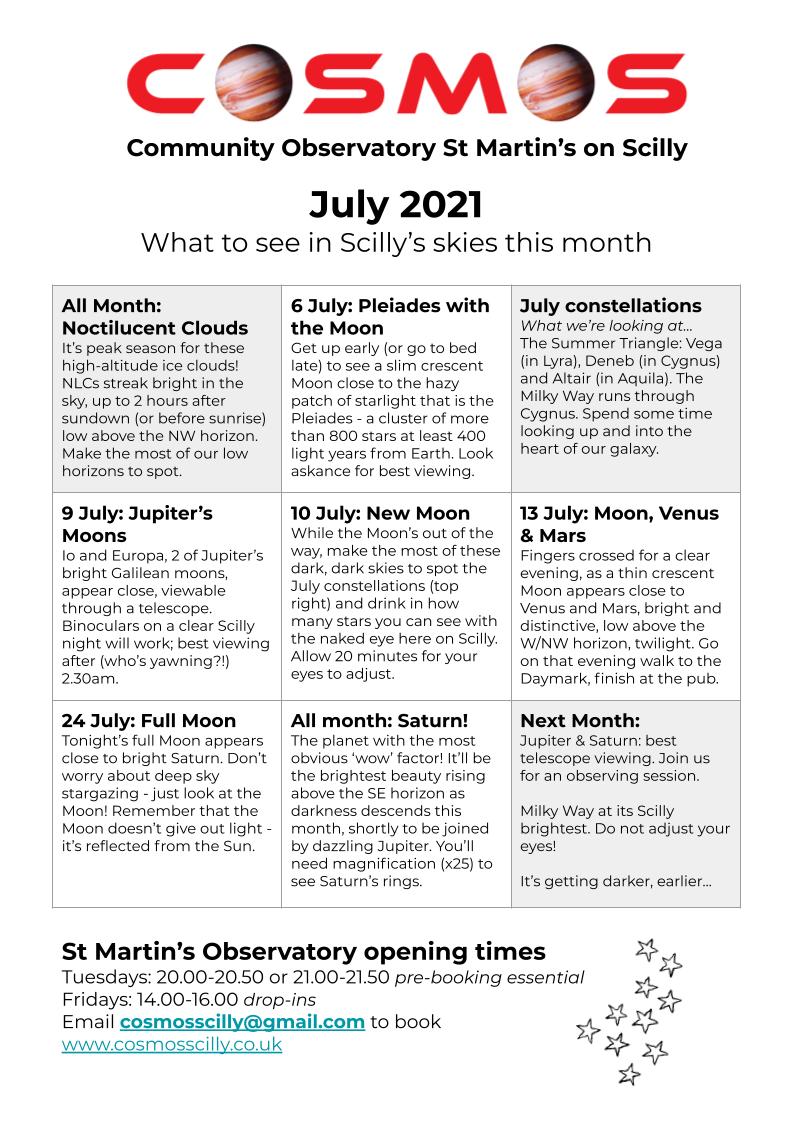
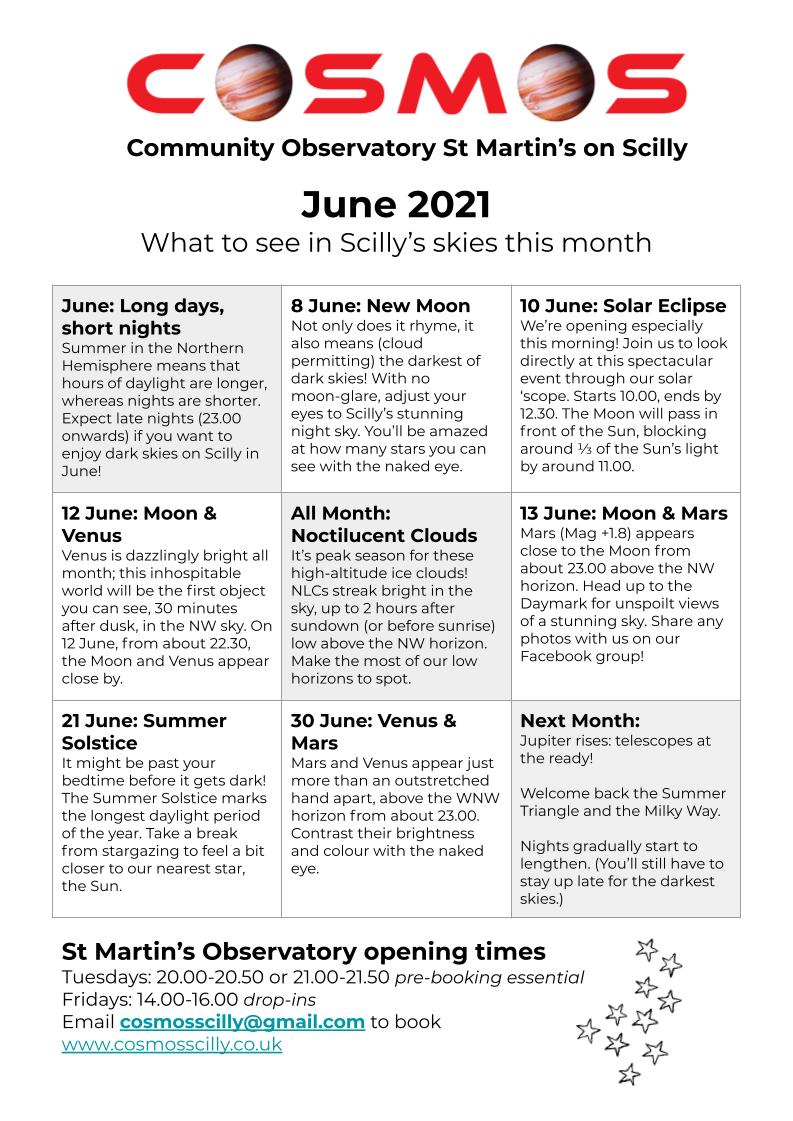

 RSS Feed
RSS Feed